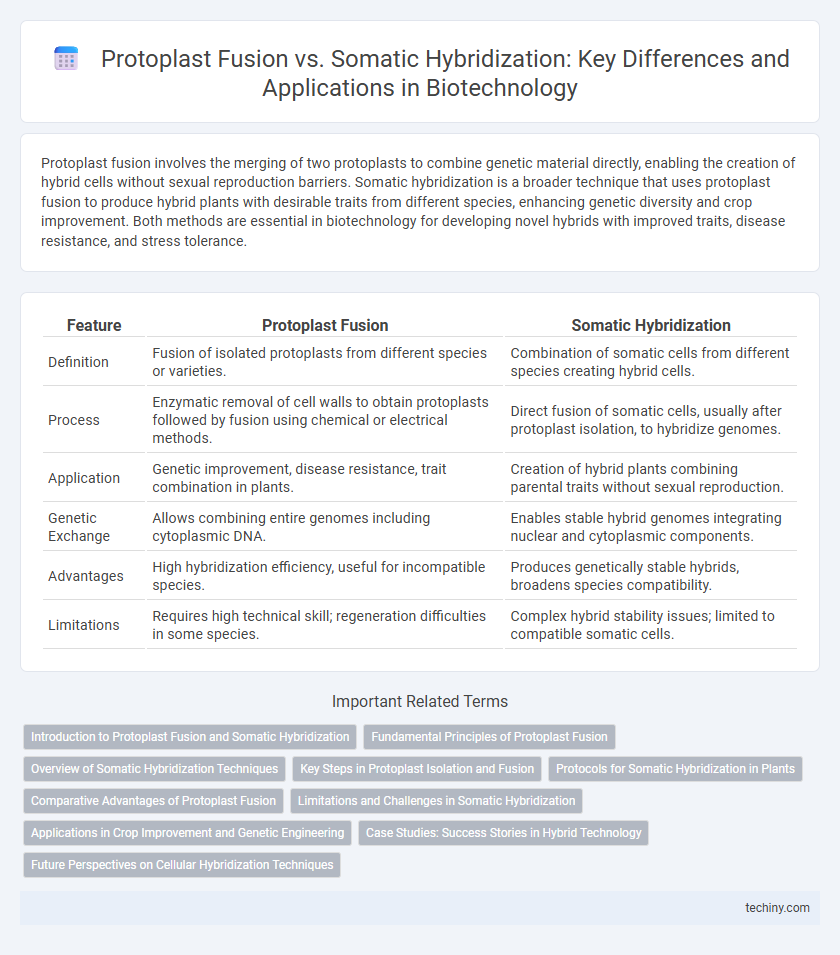Protoplast fusion involves the merging of two protoplasts to combine genetic material directly, enabling the creation of hybrid cells without sexual reproduction barriers. Somatic hybridization is a broader technique that uses protoplast fusion to produce hybrid plants with desirable traits from different species, enhancing genetic diversity and crop improvement. Both methods are essential in biotechnology for developing novel hybrids with improved traits, disease resistance, and stress tolerance.
Table of Comparison
| Feature | Protoplast Fusion | Somatic Hybridization |
|---|---|---|
| Definition | Fusion of isolated protoplasts from different species or varieties. | Combination of somatic cells from different species creating hybrid cells. |
| Process | Enzymatic removal of cell walls to obtain protoplasts followed by fusion using chemical or electrical methods. | Direct fusion of somatic cells, usually after protoplast isolation, to hybridize genomes. |
| Application | Genetic improvement, disease resistance, trait combination in plants. | Creation of hybrid plants combining parental traits without sexual reproduction. |
| Genetic Exchange | Allows combining entire genomes including cytoplasmic DNA. | Enables stable hybrid genomes integrating nuclear and cytoplasmic components. |
| Advantages | High hybridization efficiency, useful for incompatible species. | Produces genetically stable hybrids, broadens species compatibility. |
| Limitations | Requires high technical skill; regeneration difficulties in some species. | Complex hybrid stability issues; limited to compatible somatic cells. |
Introduction to Protoplast Fusion and Somatic Hybridization
Protoplast fusion involves the merging of cell membranes from two distinct protoplasts to combine genetic material without sexual reproduction, enabling the creation of novel hybrids across species barriers. Somatic hybridization is a biotechnological technique that produces hybrid plants by fusing somatic cells, bypassing incompatibility issues encountered in conventional breeding. Both methods facilitate genetic recombination for crop improvement, disease resistance, and enhanced traits in plant biotechnology.
Fundamental Principles of Protoplast Fusion
Protoplast fusion involves the enzymatic removal of plant cell walls to create protoplasts, which are then induced to fuse using chemical agents like polyethylene glycol (PEG) or electrical fields. This technique enables direct combination of genetic material from different species or varieties, bypassing sexual compatibility barriers. The fundamental principle relies on membrane fusion and subsequent regeneration of hybrid cells capable of developing into whole plants with novel traits.
Overview of Somatic Hybridization Techniques
Somatic hybridization involves the fusion of protoplasts from different plant species or varieties to create hybrid cells, bypassing sexual reproduction barriers. Techniques such as electrofusion, polyethylene glycol (PEG)-mediated fusion, and chemical-induced fusion are commonly employed to achieve successful protoplast fusion. These methods facilitate the combination of desirable traits from distinct genotypes, enabling the development of novel hybrids with enhanced genetic diversity and improved crop characteristics.
Key Steps in Protoplast Isolation and Fusion
Protoplast isolation involves enzymatic digestion of plant cell walls using cellulase and pectinase enzymes to release naked protoplasts, followed by purification through density-gradient centrifugation. Fusion of protoplasts is typically induced by chemical agents such as polyethylene glycol (PEG) or by applying electrical pulses in electrofusion to facilitate membrane merging. Key steps include ensuring high viability of isolated protoplasts, optimizing enzyme concentrations and incubation times, and controlling fusion conditions to maximize hybrid cell formation efficiency.
Protocols for Somatic Hybridization in Plants
Protocols for somatic hybridization in plants involve isolating protoplasts from parent species followed by enzymatic digestion to remove the cell wall. Fusion methods such as polyethylene glycol (PEG)-mediated fusion or electrofusion are applied to merge the protoplasts, promoting hybrid cell formation. Regeneration of hybrid plants from fused protoplasts requires optimized culture conditions with precise nutrient media and growth regulators to ensure successful shoot and root development.
Comparative Advantages of Protoplast Fusion
Protoplast fusion enables the direct combination of genetic material from different plant species by fusing their isolated protoplasts, facilitating the creation of hybrids that are impossible through traditional breeding methods. It allows for precise control over hybridization, resulting in higher efficiency and success rates compared to somatic hybridization, which relies on less defined cellular interactions. This technique accelerates the development of novel traits such as disease resistance and stress tolerance by overcoming species barriers more effectively than conventional somatic hybridization approaches.
Limitations and Challenges in Somatic Hybridization
Somatic hybridization faces significant limitations such as low efficiency in protoplast fusion and difficulty in regenerating viable hybrid plants due to genetic incompatibility. Challenges also include somaclonal variation and instability in hybrid genomes, leading to unpredictable phenotypic traits. Furthermore, the process requires specialized tissue culture facilities and expertise, increasing the complexity and cost of biotechnological applications.
Applications in Crop Improvement and Genetic Engineering
Protoplast fusion enables the combination of genetic material from distinct plant species, facilitating the development of hybrids with improved traits such as disease resistance, stress tolerance, and enhanced yield. Somatic hybridization allows the incorporation of desirable genes without sexual compatibility barriers, accelerating the production of novel crop varieties with superior agronomic characteristics. Both techniques are pivotal in genetic engineering for introducing valuable traits, overcoming hybridization limitations, and expanding the genetic diversity necessary for sustainable crop improvement.
Case Studies: Success Stories in Hybrid Technology
Protoplast fusion has demonstrated significant success in hybrid technology, as seen in the development of disease-resistant potato varieties through the fusion of Solanum tuberosum and wild relatives like Solanum brevicaule. Somatic hybridization enabled the creation of citrus hybrids combining traits from Citrus reticulata and Poncirus trifoliata, improving cold tolerance and disease resistance. These case studies highlight the practical applications of hybrid technology in agriculture, showcasing enhanced crop resilience and productivity through cell fusion techniques.
Future Perspectives on Cellular Hybridization Techniques
Future perspectives on cellular hybridization techniques emphasize enhanced precision and efficiency in protoplast fusion and somatic hybridization, enabling the creation of novel hybrids with improved traits for agriculture and pharmaceuticals. Advances in CRISPR-Cas9 and other genome editing tools are expected to integrate with these methods, accelerating the development of genetically enhanced cell lines. Emerging bioinformatics platforms will optimize hybrid selection and stability, driving breakthroughs in stress resistance, disease tolerance, and metabolite production.
Protoplast Fusion vs Somatic Hybridization Infographic

 techiny.com
techiny.com